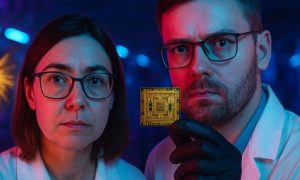

Introduction
The exponential growth of artificial intelligence (AI) and nanotechnology is transforming every facet of modern life, and nowhere is this impact more profound than in the domain of global security. In 2025, nations are increasingly leveraging these technologies to enhance military capabilities, surveillance systems, and national defense strategies. However, with innovation comes risk. AI drones and nanotechnology present dual-use dilemmas—while they can strengthen security, they can also be exploited by malicious actors, thus creating volatile threats to international stability.

This article explores how AI drones and nanotechnology are reshaping the global security architecture. Specifically, it focuses on the United Kingdom, Europe, Asia, and the Middle East. Beyond military deployment, this analysis incorporates their implications on cyber warfare, chemical threats, nuclear safety, and terrorism. By examining regional developments and global trends, we assess the multilayered threats posed by these technologies and offer a roadmap for responsible and secure implementation.
AI Drones: A Double-Edged Sword
AI-powered drones have evolved far beyond their initial role in surveillance. Today, autonomous drones are capable of identifying, targeting, and neutralizing threats with minimal human intervention. The UK, in collaboration with companies such as [Faculty AI](https://www.thefaculty.ai) and Hadean, is spearheading the development of AI-integrated drone systems for defense and border control (Army Recognition, 2024).

Ukraine has embraced this transformation amidst its ongoing conflict with Russia, using AI drones to resist sophisticated electronic warfare jamming (Reuters, 2024). These drones adapt in real time, processing data to avoid detection or counterattack. Such capabilities make AI drones not only effective but also harder to regulate under conventional arms control frameworks.
However, the growing autonomy of drones also raises critical questions about accountability. Who is responsible if an AI drone misidentifies a civilian as a threat? These questions underscore the urgent need for international treaties governing autonomous warfare.
Nanotechnology: The Invisible Threat
Nanotechnology promises breakthroughs in materials science, medicine, and communications—but its implications for global security are just as revolutionary. On the battlefield, nanomaterials are now being used to create lighter and stronger armor, self-healing aircraft skins, and undetectable surveillance devices.

Yet, perhaps the most chilling risk lies in the development of weaponized nanobots. The hypothetical “grey goo” scenario—where self-replicating nanobots consume all matter—may sound like science fiction, but the possibility of rogue states or terrorists using nanotech for bioterrorism is real (Wikipedia, 2024).
Additionally, nanoparticles capable of penetrating biological tissue raise the threat of undetectable poison delivery or targeted assassinations. With their size making them extremely difficult to track or defend against, nanotechnology opens up a new, virtually invisible front in the security arena.
Cybersecurity: The AI-Nano Convergence

AI and nanotechnology are converging in the cybersecurity domain as well. AI enhances the detection and neutralization of cyber threats, while nanotech is revolutionizing hardware-level security by embedding smart sensors into microchips and networks.
However, the risk of AI-enhanced malware and deepfakes cannot be overstated. State-sponsored hacking groups now employ AI to adapt attacks in real time, bypassing conventional firewalls. China’s military cyber doctrine has embraced this shift, blending kinetic warfare with sophisticated cyber capabilities (Wikipedia, 2024).
Moreover, quantum computing advancements powered by nanotech components could break current encryption methods, rendering global communications vulnerable unless proactive countermeasures are implemented.

Chemical Warfare and Biosecurity
Nanotechnology is playing a dual role in chemical and biological security. On the one hand, it enables the creation of early detection biosensors for chemical weapons. On the other, it could be misused to develop more lethal chemical agents that are harder to detect.
For example, nanoparticles can be used to enhance the delivery of neurotoxins, making them more effective and targeted. Rogue regimes or terrorist organizations could weaponize these technologies to bypass conventional chemical weapons bans, as outlined in the Chemical Weapons Convention (CWC).

In this light, nanotechnology must be tightly regulated to prevent its misuse in chemical and biological warfare, and global institutions must evolve to include nanotech under existing non-proliferation treaties.
Nuclear Security: A New Frontier
AI is also changing how nuclear arsenals are managed. AI systems can enhance early warning systems and decision-making processes, potentially reducing the risk of accidental launches. However, integrating AI into nuclear command-and-control systems introduces new vulnerabilities—especially if these systems are targeted by AI-driven cyberattacks.
Additionally, nanotech has applications in uranium enrichment and nuclear material detection. While this could bolster nuclear safety and monitoring efforts by the International Atomic Energy Agency (IAEA), it also poses risks if used clandestinely by states developing nuclear capabilities.
As tensions rise in regions like the Middle East and South Asia, the intersection of AI, nanotech, and nuclear assets could destabilize deterrence models that have long prevented full-scale conflict.

Terrorism and Non-State Actors
Terrorist groups are increasingly aware of the strategic benefits offered by emerging technologies. DIY drone kits with AI components are now accessible online, and nanotechnology has the potential to produce portable, undetectable devices for targeted attacks.
A 2025 report from Europol warns that terrorist organizations may attempt to weaponize AI for disinformation campaigns, automated propaganda bots, or digital surveillance evasion. These strategies are not only cost-effective but also difficult to trace back to the perpetrators.
In the Middle East and North Africa (MENA) region, non-state actors with minimal infrastructure but significant motivation could level the playing field through asymmetric warfare made possible by AI and nanotech.

Regional Implications Revisited
United Kingdom
The UK has emerged as a leader in ethical AI regulation, launching the [AI Safety Institute](https://www.gov.uk/government/news/ai-safety-institute-launched) and engaging with firms like [Faculty AI](https://www.thefaculty.ai) and Hadean. These initiatives aim to balance innovation with risk, particularly in defense and surveillance applications. Nevertheless, concerns about autonomous decision-making in warfare persist, as highlighted in a 2024 UK Parliamentary report.
Europe
European countries continue to support AI integration into their militaries through entities such as the European Defence Agency (EDA). However, legal and ethical considerations are central to policymaking. The European Institute for International Law and International Relations has called for an EU-wide directive to govern lethal autonomous weapons systems (LAWS).

France and Germany are exploring joint ventures in AI drone development while simultaneously investing in nanotech defense applications, reflecting a dual focus on innovation and caution.
Asia
China’s “intelligentized warfare” strategy continues to dominate the region’s defense innovation narrative. The People’s Liberation Army (PLA) integrates AI, nanotech, and cyber capabilities, prompting nearby nations like India and Japan to scale up their technological defense ecosystems.
The South China Sea, Taiwan Strait, and Korean Peninsula are all flashpoints where AI drones and nanotech surveillance tools are increasingly deployed.

Middle East
Countries like the UAE, Israel, and Saudi Arabia are pouring billions into smart defense technologies. While these investments promise enhanced border security and counterterrorism effectiveness, they also risk escalating regional arms races. Iranian-backed militias have shown interest in AI-based tactics, underscoring the diffusion of tech beyond state control.
Ethical and Legal Considerations
Global legal frameworks are struggling to keep pace with AI and nanotech development. The Geneva Conventions, for example, do not adequately address autonomous systems or nanotech applications. The UN Institute for Disarmament Research (UNIDIR) has called for new protocols to define accountability, especially concerning autonomous weapons.
Meanwhile, academic institutions and think tanks, including Chatham House, have stressed the need for international cooperation, public transparency, and democratic oversight.

AI WORLD CONGRESS 2025
Conclusion
In 2025, AI drones and nanotechnology have reached a pivotal point in shaping the global security narrative. While these technologies offer transformative benefits for defense, medicine, and communications, they also carry risks that could disrupt the global order if left unchecked.
As these technologies become increasingly accessible, the threat from non-state actors, rogue nations, and cyber adversaries grows in parallel. The international community must move quickly to adapt legal structures, establish enforceable ethical norms, and invest in cooperative security solutions. Global security in the AI-nano era will depend not just on technological superiority, but on collective wisdom and restraint.

This article examines the emerging threats associated with AI drones and nanotechnology across the UK, Europe, Asia, and the Middle East. By analyzing current developments and their implications, we aim to provide a comprehensive understanding of how these technologies are influencing global security dynamics.
References
- UK Government. (2023). Prime Minister calls for global responsibility to take AI risks seriously and seize its opportunities. Retrieved from https://www.gov.uk/government/news/prime-minister-calls-for-global-responsibility-to-take-ai-risks-seriously-and-seize-its-opportunities
- UK Government. (2025). International AI Safety Report 2025. Retrieved from https://www.gov.uk/government/publications/international-ai-safety-report-2025
- SourceSecurity. (2025). AI and drones: Security trends for 2025. Retrieved from https://www.sourcesecurity.com/insights/security-predictions-2025-ai-drones-retail-co-1201-ga-co-2293-ga-co-2900-ga-co-3025-ga-co-12074-ga-co-14836-ga-co-1734937080-ga-sb.1734937462.html
- UK Government. (2025). Tackling AI security risks to unleash growth and deliver Plan for Change. Retrieved from https://www.gov.uk/government/news/tackling-ai-security-risks-to-unleash-growth-and-deliver-plan-for-change























